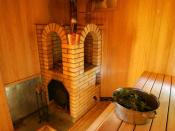Search
Login
How to choose natural wallpaper, the benefits of using natural wallpaper in the interior
The desire of a modern resident of the metropolis to plunge into the natural environment is quite natural - there is nothing more beautiful in the world than the aroma of a flowering meadow, the murmur of a stream, a portion of fresh air and the feeling of touching natural materials created by nature itself.
Content
- Reasons for the popularity of natural materials video
- The benefits of natural wallpaper video
- Varieties of natural wallpaper
- How to glue natural wallpaper video
Reasons for the popularity of natural materials

It is they who strive to make the most of today in the construction of housing and its decoration. Eco-design is becoming increasingly popular, in the arsenal of which today there is a fairly extensive collection of unique finishing materials, including natural wallpaper. It is this type of decoration that many of us prefer, and it has quite good reasons. Natural wallpaper in the interior:
- They allow you to successfully cope with the task of styling rooms.
- They create a special comfortable atmosphere in the rooms, which is conducive to relaxation or work.
- They look attractive and original, surprise with a wealth of colors and textures.
The benefits of natural wallpaper
Wallpaper made of natural materials is an environmentally friendly product, they are made by hand. As a basis, non-woven or paper is used. The outer side is decorated with threads from fibers of natural plants: jute, bamboo, reed, arrowroot, Chinese nettle, woody leaves, sisal, papyrus, as well as veneer made from mahogany.
Naturally, many positive qualities are inherent in natural materials:
- Environmental friendliness, not a tendency to release toxic substances when heated and burned.
- Permeability to air, excellent sound insulation, moisture resistance and wear resistance.
- The ability to create a special microclimate in the room, favorable for humans.
- A format convenient for gluing is 91 cm wide and 5.5 or 10 m long.
- Extreme simplicity in work - when gluing, you can do without special tools, special abilities and knowledge of construction technologies are also not needed.
- Good compatibility with wood, tile, decorative plaster. Resistant to insects and molds.
Natural tapestries are used for gluing ceilings and walls; if desired, they can decorate furniture.
Varieties of natural wallpaper
From natural wood

Wallpaper made on the basis of natural wood is very aesthetic and practical, creating a special microclimate filled with natural energy. For manufacturing, thin sections of valuable wood species are used, paper is used as the basis. The unique surface pattern allows you to create a stylistic orientation of the interior, acceptable for rooms for various purposes: living room, bedroom, nursery.
Plant-based

Plant-based finishing materials are made from jute, sesal, goldflower, the base is non-woven or paper. Plant fibers are glued in clear lines or randomly; in any case, the surface of the material looks aesthetically pleasing and elegant. They glue the walls and ceilings, use them as fragments on the walls to create accents in the interior. They blend perfectly with painted walls and ceilings or with paper wallpapers. Usually used to decorate bedrooms and living rooms. It is not recommended to cover the walls in kitchens with such wallpapers - they are prone to absorb odors.
With a bamboo component

Natural wallpaper made of bamboo is no less popular, to be more precise, it includes a bamboo component. Made from thinly sliced \u200b\u200bbamboo slats. As for the amazingly beautiful shades of the material, they are obtained thanks to the luxurious color that different varieties of this plant have: from white to yellowish, from greenish to brown. The natural beauty of the material allows you to not use paints and varnishes when decorating walls. You can use such wallpapers in rooms, bedrooms, nurseries, in the kitchen or even in the bathroom - bamboo wallpapers in the interior are considered classics of style, their embossed surface can give originality to any room.
Cork

Cork-based wallpapers are made from bark of cork oak pressed in a special way. Among the main advantages of this material, it is worth recalling its practicality and durability, resistance to temperature extremes and moisture, the material is inherently non-flammable and may even prevent the spread of fire in case of fire. Moisture is not conditioned on the surface of such a material, it perfectly protects the premises from noise, and has good thermal insulation properties. They use cork wallpaper in living rooms, bedrooms and nurseries, they look great in the corridors, on the kitchens, in the bathrooms.
From the leaves

Wallpaper made from leaves is a relatively new kind of finish. It is unlikely that it can be attributed to practical and durable, even with small loads the leaves break. Therefore, the optimal application for this very beautiful material is to create panels, finish niches or paste the ceiling. 4
How to glue natural wallpaper
- Firstly, for such wallpapers there is a special glue, but if you do not want to look for it, then you can use glue designed for heavy vinyl materials.
- Before starting work, you should print the rolls and stand them for several hours in the room where they will be glued.
- In the process, you will need to additionally apply glue to the surface to be glued.
- Before gluing the wallpaper should be allowed to saturate with glue.
- Drafts should not be allowed in the room, it is not recommended to ventilate it, the temperature should be the same throughout the whole time.
- Excess adhesive on the front of the material should be cleaned with a dry sponge.
The use of natural wallpaper is a great opportunity for each of us to approach the creation of an environmentally friendly home with a colorful, elegant, attractive interior.





